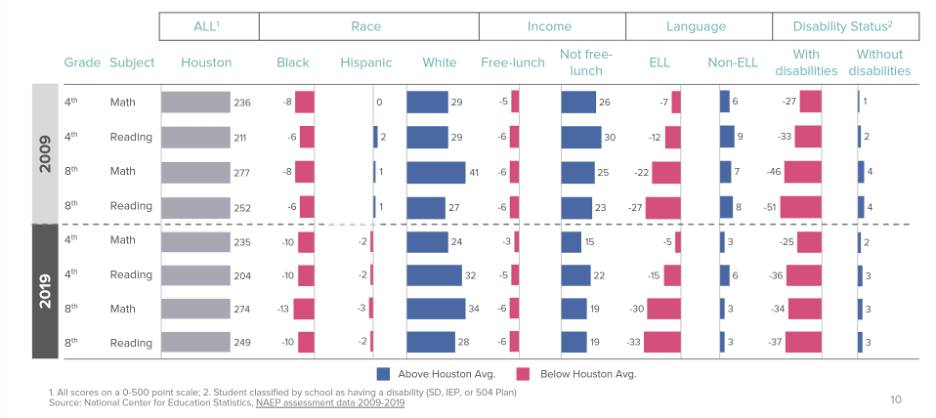This week the Houston ISD Board of Managers approved the Teacher Excellence System (TES), Superintendent Miles’ new teacher appraisal system for the district. For the 2023-2024 school year, teachers at New Education System (NES) campuses, HISD’s priority resourced schools, and NES-Aligned (NES/A) schools, campuses that voluntarily adopted the instruction model, will be evaluated using this new system. The following school year, the district plans to utilize TES district-wide.
Key elements of TES are outlined in guiding principles, which emphasize that appraisal must be fair, accurate, and rigorous with a particular focus on student outcomes and individual contributions to student learning. TES is aligned with professional development supports and compensation. A full overview of TES is available on the HISD website. We highlight some of the main characteristics of TES below.
The Need for Effective Evaluation
Teachers and the instruction they provide students are the single most important factor for student success. Educator evaluation plays a critical role in ensuring students receive high-quality instruction and teachers receive the support they need to provide it. Robust appraisal systems promote and reward effectiveness by setting clear expectations and drive professional development by highlighting areas in need of adjustment.
Appraisals not only function as a means of feedback for continuous improvement, but they also shine a light on best practices to support student growth. Research shows that in one school year students assigned to a high-performing teacher can gain up to an additional year’s worth of academic growth when compared to students being taught by low-performing teachers. District and campus leaders must be able to identify highly-effective educators and incentivize them to serve students on campuses that have the most need.
A look to HISD’s past underscores how important this is. In 2019 under the previous Teacher Appraisal and Development System (TADS), the schools with the highest need for quality instruction were more than three times as likely to have teachers that were rated “ineffective” and “needs improvement” than higher-performing campuses. In fact, at that time, campuses that received an “A” rating had more than six times the proportion of teachers who were “highly effective” than campuses with an “F” rating. To address the misalignment, HISD has worked in recent years to improve its teacher evaluation system, which appears to be echoed by Superintendent Miles with TES.
A national perspective on student achievement provides additional context and emphasizes the need for a focus on excellent instruction for every student. The National Assessment of Educational Progress (NAEP) is a federally mandated and nationally normed test. HISD participates along with 26 other school districts across the country as a means of national comparison. Our analysis of NAEP scores shows that 76% of HISD students in 4th grade math and 81% in 4th grade reading are below the Proficient level, higher than the national average. This inches up to 82% for both 8th grade math and 8th grade reading. A deeper look shows that gaps between groups of students have increased over the last decade for Black, Hispanic, and English Learner students.


Highlights of the TES System
At the outset, Superintendent Miles’ through TES recognizes the need for effective evaluation and how it intersects with student outcomes, professional development, and district goals. Here are some highlights of the new system:
STUDENTS ARE A CLEAR FOCUS OF THE SYSTEM
Ultimately the function of a school district must always be aligned with what matters most: student learning. TES clearly serves this purpose by allocating up to 45% percent of a teacher’s overall appraisal score to student-focused metrics.
For every educator, 35% of the TES evaluation is based on student achievement data or student learning objectives. These measures prioritize student outcomes and almost all assess teachers on their individual contribution to student growth. TES looks at multiple assessments, depending on grade level and subject, and tracks growth throughout the school year.
For most teachers in grades 3-12, an additional 10% of TES offers students a voice in the process through student surveys. While observations and outcome data give snapshots of classroom learning, students can provide a perspective of their classroom environment throughout the school year. Effective student surveys are research-based and aligned to nationally-recognized standards that prompt students to share their experiences in a way that provides meaningful feedback.
MULTIPLE METRICS OFFER A COMPREHENSIVE VIEW OF EFFECTIVENESS
While some teacher appraisal systems focus only on classroom observations, importantly, TES offers a more comprehensive view. Educators are scored on multiple metrics, with up to seven different measures for core subject teachers. In addition to student achievement and student surveys, TES allocates up to 50% of scoring to educator performance, prioritizing quality of instruction (30%) and additional areas like classroom environment and meeting diverse student needs (up to 20%).
While no measure of performance is perfect, using multiple measures helps compensate for flaws of individual components, while maximizing benefits. Research has found that observation scores are more accurate and reliable when combined with student achievement and student surveys. Highly effective educators are multi-faceted. This type of evaluation recognizes that strong instruction must not only be properly delivered, but also demonstrably meet student needs.
ALL SUBJECTS AND GRADE LEVELS ARE INCLUDED
TES reflects the reality that differentiation is needed to fairly assess teachers across grade levels and subject areas. Teachers are divided into categories based on the data and evaluation measures available for their specific area of instruction. For example, core subject teachers in grades 3-12 will generally fall into category A, which includes both student growth data from assessments and student surveys.
On the other hand, teachers in elective courses are not tested in the same way as core subjects, so TES evaluates student growth based on student learning objectives that are set by the educator and monitored throughout the school year. Teachers in early grades have slightly different weights to their evaluation because their students are too young to take student surveys.
FEEDBACK IS FREQUENT AND PROFESSIONAL DEVELOPMENT IS INTEGRATED
A core tenant of teacher evaluation is providing teachers with actionable information to improve student learning and the support necessary to implement instruction. TES incorporates feedback throughout the school year, not just at scheduled meetings. Teachers receive 8 or more spot observations (around one a month), where they are given feedback in addition to day-to-day coaching and informal observations by supervisors.
Further, the whole system is tied to professional development. Professional development topics align with areas of the evaluation system, which all teachers receive training on in the first semester. Later in the school year, professional development turns to progress areas for individual schools and components that have been identified through TES for improvement. This process should offer educators the support necessary to meet the expectations set by the evaluation system.
Looking Forward
Superintendent Miles’ overview of TES, like professional development for educators, recognizes continuous improvement is a necessary component of an appraisal system. As HISD continues to monitor the progress of teachers, student outcomes, and quality of instruction throughout the district, adjustments may need to be made in the future to continue serving students. Looking to the future, we recommend that the district keep these things in mind as it revisits the appraisal system:
- Keep the Teacher Incentive Allotment (TIA) in Sight. Texas law sets aside funding for districts that have demonstrated their teacher evaluation system is valid and reliable. By applying for TIA, districts can get additional state funding to compensate highly-effective educators. Superintendent Miles has indicated that HISD intends to pursue TIA and we anticipate any future changes to TES will strive to meet statutory requirements to meet that goal.
- Continue to Monitor Best Practices and High-Quality Instruction. One of the key components of TES is instructional quality, which aligns with HISD’s focus on high-quality instructional materials (HQIM), especially at NES campuses. As district administration evaluates potential changes, TES should continue to be reflective of pedagogical best practices and support implementation of HQIM, specifically within the instructional quality rubric.
- Ensure the District Incentivizes Effective Educator Retention and Placement on High-Need Campuses. TES is focused on not only identifying effective educators, but also providing incentives to serve on campuses with the highest need for quality instruction. The system does this through differentiated compensation and additional weights for teaching at NES campuses. As TES is implemented, HISD will need to keep an eye on recruitment and retention trends. It will also need to track placement of teachers to ensure the system continues to meet district goals for NES campuses.

